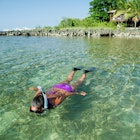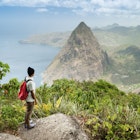
May 8, 2025 • 5 min read
From elevated Jewish cuisine to quite possibly the world’s best breakfast burrito, our Brooklyn writer shares her favorite local haunts.

May 8, 2025 • 5 min read
From elevated Jewish cuisine to quite possibly the world’s best breakfast burrito, our Brooklyn writer shares her favorite local haunts.

May 8, 2025 • 7 min read
Dive into Honduras and explore its preserved Maya sites, incredible wildlife, culture and nightlife with our guide to getting the best out of your trip.

May 8, 2025 • 6 min read
With more than 100 official wine regions in Spain, there are scores of bodegas, or wineries, to visit and sample.

May 8, 2025 • 3 min read
We've got all the insider tips and tricks you need to travel light for a travel to Spain.

May 8, 2025 • 9 min read
Check out these stalwarts of the Formula 1 circuit for the best race experiences.

May 8, 2025 • 8 min read
An expert biker shares his tips for planning a motorcycle trip in India.

May 8, 2025 • 6 min read
China offers a unique-in-the-world mix of ancient heritage and modern life. Get a taste of the country with our list of the best things to do in China.

May 8, 2025 • 5 min read
Mexican culture is deeply linked to Mexican cuisine, making it incredibly easy and fun to experience both simultaneously.

May 8, 2025 • 8 min read
New York City can keep you interested for a lifetime. Here are 15 of the most fun, culturally enriching and awe-inspiring things to do.

May 8, 2025 • 9 min read
From what to do (think saunas, lakes and Santa’s workshop) to when to go and what you’ll spend, here’s everything you need to know about visiting Finland.

May 8, 2025 • 8 min read
Given that Europe shines bright all year, the decision on when to travel to Europe depends on your budget and what you hope to do while there.

May 8, 2025 • 7 min read
Get to know Morocco’s pristine capital, Rabat, with this guide for first-time visitors.

May 7, 2025 • 6 min read
The dazzling diversity of mountains, deserts, beaches and ancient cities in Morocco brings your senses to life.

May 7, 2025 • 9 min read
The Indonesian island of Lombok is Bali’s calmer cousin, famed for sun, sand, sea, surf and the epic hike up the Gunung Rinjani volcano.

May 7, 2025 • 6 min read
China is astonishingly huge, amazingly diverse – and remarkably well connected. Here’s how to get around the country by train, bus, bicycle and more.

May 7, 2025 • 7 min read
Our all-time favorite national parks in the West, Alaska and Hawaii cover gravity-defying arches and expansive canyons to towering peaks and volcanoes.

May 7, 2025 • 10 min read
See the top destinations for a first trip to Hungary, plus tips on costs and when to visit its beautiful capital, thermal spas and exciting vineyards.

May 7, 2025 • 7 min read
Stay connected on your trip Down Under with these helpful tips.

May 7, 2025 • 8 min read
In between lying out on the beach, consider hiking, tasting rum, soaking in a mud bath and more of our favorite things to do in St Lucia.

May 7, 2025 • 13 min read
Plan your time in Greece with our pick of the best islands.

May 7, 2025 • 8 min read
Whether your passion is surfing, hiking, bird-watching or kiteboarding, Mexico is the place for outdoor advetnures. These are the country’s top ones.

May 7, 2025 • 8 min read
From popular, family-friendly stretches of sand to secret coves you'll have all to yourself, these are the best beaches in beautiful Bermuda.